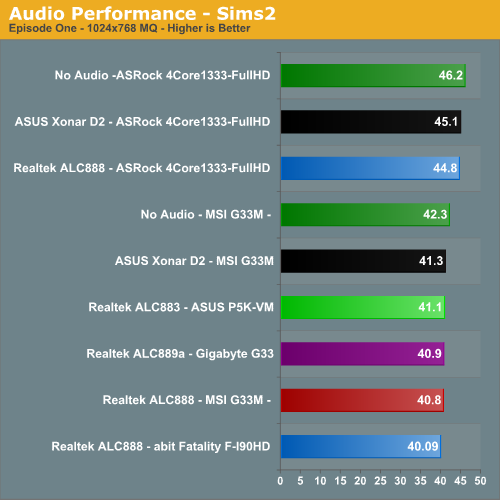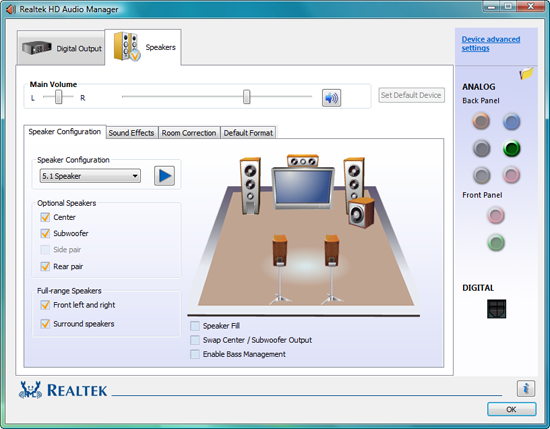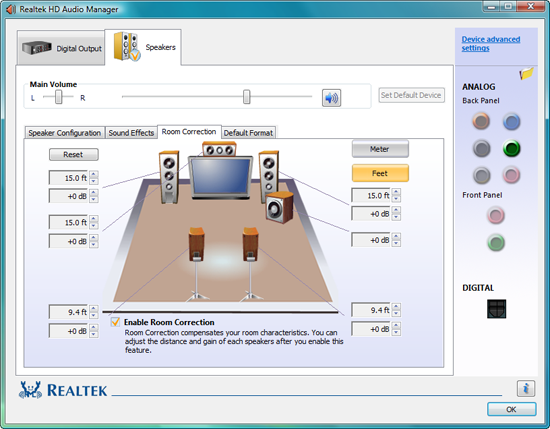µATX Part 2: Intel G33 Performance Review
by Gary Key on September 27, 2007 3:00 AM EST- Posted in
- Motherboards
Audio Performance
Vista has brought about major changes in the audio stack and as such we will have a dedicated article next month on this subject along with a performance/quality comparison of the latest sound cards. The excellent Rightmark Audio Analyzer is not fully compatible with Vista yet, so objective benchmarks are not available with this tool. We are working with 6.0.6 release now and will have an update shortly. In the meantime, we will only present a single game result today as the general performance, or lack thereof, of the Intel GMA3100 leads us with one current game in our test suite that can be accurately tested.

The audio performance numbers remain consistent between the Realtek ALC888 and ASUS Xonar D2 solutions with either the on-board or add in GPU. The CPU utilization rates and effects on our game benchmarks are minimal since 3D audio positioning (DirectSound 3D/EAX 2) is not available under Vista for these host-based audio solutions. This is a positive from a performance viewpoint when considering frame rate hits under XP in such games as Battlefield 2 reflect an average loss of 22%, Half Life 2- Episode One at 6%, and Company of Heroes at 5%.
After comparing the ASUS Xonar D2 to the Realtek offerings in each of our games it was difficult to hear any substantial differences in Half Life Two - Episode One while there was a clear difference in Battlefield 2 and Company of Heroes. Even though 3D audio positioning is not available, the general ambient sounds and especially weapon sounds definitely sounded better on the Xonar D2 with explosions actually having an impact instead of sounding like a nail dropping on a tin roof. For those wondering about results with the Creative X-FI, we will have those in the upcoming audio comparison article as the latest drivers have left us with screeching sounds in BF2 and Company of Heroes.
There was no comparison in our music and video playback tests where the Xonar D2 just annihilated the Realtek ALC888/883 implementation. The Realtek ALC889a offering on the Gigabyte board certainly sounded better than the other Realtek codecs but was still outclassed by the Xonar. This is not surprising and should be expected but during the intense action sequence on the bridge in Mission Impossible III, the Realtek ALC888/883 output during the drone's flyby sequences sounded something like a beached whale when the missiles were fired and then again upon impact. We did make some adjustments with the Realtek control panel and fine tuned our speaker locations/receiver settings which did improve the audio output quality when utilizing the analog connections. These problems were somewhat mitigated when using the S/PDIF output on the ASUS board.
We have to wonder what Gigabyte was thinking by not offering an coaxial or optical output on a board with the Realtek ALC889a considering the improvements over the previous codec families. Overall we suggest buying a decent audio card if you plan on using your computer as a media or gaming station.


The Vista audio control panel for the Realtek HD codec offers a wide range of options to setup your speakers although a headphone setting and equalizer are not available. For those on a budget, the out of box experience with the Realtek solution is acceptable enough for everyday usage until one can afford a better solution.
Vista has brought about major changes in the audio stack and as such we will have a dedicated article next month on this subject along with a performance/quality comparison of the latest sound cards. The excellent Rightmark Audio Analyzer is not fully compatible with Vista yet, so objective benchmarks are not available with this tool. We are working with 6.0.6 release now and will have an update shortly. In the meantime, we will only present a single game result today as the general performance, or lack thereof, of the Intel GMA3100 leads us with one current game in our test suite that can be accurately tested.

The audio performance numbers remain consistent between the Realtek ALC888 and ASUS Xonar D2 solutions with either the on-board or add in GPU. The CPU utilization rates and effects on our game benchmarks are minimal since 3D audio positioning (DirectSound 3D/EAX 2) is not available under Vista for these host-based audio solutions. This is a positive from a performance viewpoint when considering frame rate hits under XP in such games as Battlefield 2 reflect an average loss of 22%, Half Life 2- Episode One at 6%, and Company of Heroes at 5%.
After comparing the ASUS Xonar D2 to the Realtek offerings in each of our games it was difficult to hear any substantial differences in Half Life Two - Episode One while there was a clear difference in Battlefield 2 and Company of Heroes. Even though 3D audio positioning is not available, the general ambient sounds and especially weapon sounds definitely sounded better on the Xonar D2 with explosions actually having an impact instead of sounding like a nail dropping on a tin roof. For those wondering about results with the Creative X-FI, we will have those in the upcoming audio comparison article as the latest drivers have left us with screeching sounds in BF2 and Company of Heroes.
There was no comparison in our music and video playback tests where the Xonar D2 just annihilated the Realtek ALC888/883 implementation. The Realtek ALC889a offering on the Gigabyte board certainly sounded better than the other Realtek codecs but was still outclassed by the Xonar. This is not surprising and should be expected but during the intense action sequence on the bridge in Mission Impossible III, the Realtek ALC888/883 output during the drone's flyby sequences sounded something like a beached whale when the missiles were fired and then again upon impact. We did make some adjustments with the Realtek control panel and fine tuned our speaker locations/receiver settings which did improve the audio output quality when utilizing the analog connections. These problems were somewhat mitigated when using the S/PDIF output on the ASUS board.
We have to wonder what Gigabyte was thinking by not offering an coaxial or optical output on a board with the Realtek ALC889a considering the improvements over the previous codec families. Overall we suggest buying a decent audio card if you plan on using your computer as a media or gaming station.


The Vista audio control panel for the Realtek HD codec offers a wide range of options to setup your speakers although a headphone setting and equalizer are not available. For those on a budget, the out of box experience with the Realtek solution is acceptable enough for everyday usage until one can afford a better solution.










26 Comments
View All Comments
strikeback03 - Friday, September 28, 2007 - link
When building a couple computers for work using the MSI P35 Platinum board, it appears they don't support eSATA hot-swapping, at least not in XP. I know my Foxconn G965 board at home can do it. Is this behavior still present in the MSI board here? Is it a P35 limitation, or BIOS, or what?hans007 - Friday, September 28, 2007 - link
I dont get it...an svdo card (add2-n) with dvi output costs what $6 on ebay. why dont you guys just buy one, so you can test these with digital.
also the video driver in vista 32bit is not as mature still as the recently released gma 3000 compatible XP driver.
most people actually have XP so could another round of benchmarks in XP be run? I probably wont even get vista for at leas tanother year, since well its pointless and has no reason for being bought at this point.
lopri - Saturday, September 29, 2007 - link
Well.. it seems like you're using Windows XP and a monitor via VGA. Then why bother with these new IGP-based mATX boards? 915G/945G (or GeForce 6100) series would be a better choice for you. They are a lot cheaper (~$50 probably) and XP support is as mature as can be.In the center of this new wave of IGPs is the advent of HD contents. Vista is kinda necessary-evil in a sense but in general it handles HD and multimedia contents a lot better than XP and has a more intuitive/prettier UI for a living room environment. CRT has long been dead in living rooms, and if you prefer CRT over LCD for some reason (professional gaming maybe?) IGP wouldn't be an option to begin with.
I'd say DVI is the minimum requirement, HDMI w/HDCP being a preferred solution in these days and nights.
veritronx - Thursday, September 27, 2007 - link
One thing that may have been overlooked.. The MSI board is the only one suitable for people looking to use a dual-slot graphics card as well as, say, a creative sound card, with some space between them. For that reason the only board reviewed that I would look at buying would be the MSI.Ajax9000 - Thursday, September 27, 2007 - link
From page 1:Read the following Nvidia pages and the news is somewhat disappointing re HD video.
Summary PDF -- http://www.nvidia.com/object/IO_35712.html">http://www.nvidia.com/object/IO_35712.html
AMD (MCP78) features -- http://www.nvidia.com/object/mobo_gpu_features_ben...">http://www.nvidia.com/object/mobo_gpu_features_ben...
AMD (MCP78) specs -- http://www.nvidia.com/object/mobo_gpu_tech_specs.h...">http://www.nvidia.com/object/mobo_gpu_tech_specs.h...
Intel (MCP73) features -- http://www.nvidia.com/object/mcp_features_benefits...">http://www.nvidia.com/object/mcp_features_benefits...
Intel (MCP73) specs -- http://www.nvidia.com/object/mcp_intel_techspecs.h...">http://www.nvidia.com/object/mcp_intel_techspecs.h...
PureVideo is only listed for the MCP78 (7050PV+630a) combination. All the other AMD chipsets and none of the Intel chipsets have PureVideo HD.
If, in the future, they release an MCP73 using (say) 7050PV+630i then memory will be limited to DDR667.
There is no details thus far, but what would be good is if the new chipset fixes the HD Audio problem that all current HDMI video cards seem to suffer from (i.e. the problem whereby the chipset supports HD Audio, but the video cards can only accept SPDIF-grade audio for HDMI pass-through).
BansheeX - Thursday, September 27, 2007 - link
Everyone who is letting these boards have it for not including HDMI/DVI is completely right. It makes no sense. Sure, I could buy a cheap DVI graphics card and stick in there, but if I have to do that, why would I buy a board with onboard graphics in the first place?Sadly missing from this review is the board that DOES include onboard DVI, Intel's own DG33TL. Even sadder is that it takes Intel to make the feature-full board while the OEM companies go for the minimum.
Emma - Thursday, September 27, 2007 - link
I agree with the others, as most computers I build have IGP's, being able to directly compare each of the available IGP's on the market would be about the best thing from a review for a long time.The 6100/6150SE should also be included as this is still widely sold.
Also of interest would be a summary of what other nVidia and AMD IGP's are on the horizon.
Thanks!
Owls - Thursday, September 27, 2007 - link
"We generally feel that users like to install games into the same colored slots for dual channel operation, but MSI chooses to color channel A orange and channel B green."I wasn't aware you could install games into DIMM slots.
JarredWalton - Thursday, September 27, 2007 - link
Sorry 'bout that - I was helping Gary out a bit and managed to mangle the text. Blame the speech recognition. That or I'm just slurring my words a bit. :)8steve8 - Thursday, September 27, 2007 - link
great article tackling most the issues that we care about!question #1: why bother reviewing boards without DVI or HDMI?
whether we are building pc's for friends/offices etc, or an office/server box for ourselves, or we want it to find a home in its post-gaming life when we ditch it for something better... DVI will be key. inexcusable that they pinch pennies there and frankly not worth your time considering these boards. gigabyte has a g33 board with dvi/hdmi, as does intel...
http://www.newegg.com/Product/Product.aspx?Item=N8...">http://www.newegg.com/Product/Product.aspx?Item=N8...
http://www.newegg.com/Product/Product.aspx?Item=N8...">http://www.newegg.com/Product/Product.aspx?Item=N8...
question #2: this would have been muuuch more useful like 5 months ago when G33 was new. now it's about to be eclipsed by the 7150 and g35.
overall i cant wait to see a similar roundup with modern chipsets like g35/nvidia 7150/ g690 and 7050pv for amd...
would be interesting to see a cost/perf of integrated platforms including cpu costs...
mobo + cpu costs... it seems amd has some good cheap 690g boards out there, with dvi/hdmi for around $75. (almost $50 cheaper than a g33 board with dvi)...